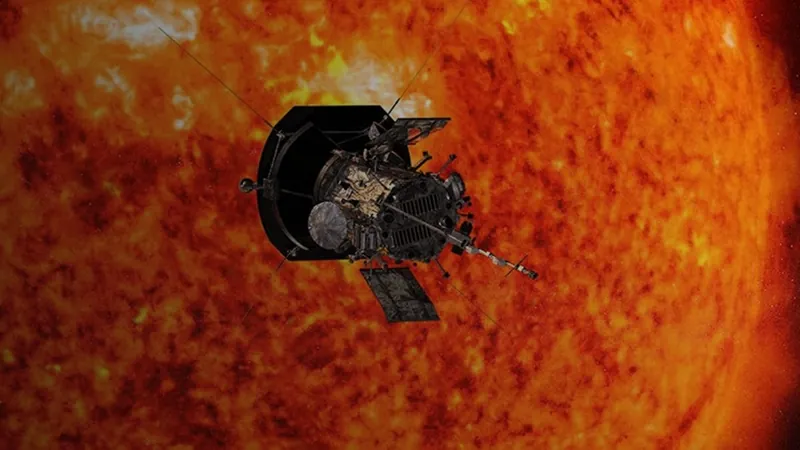
NASA's Parker Solar Probe Set to Soar Through Sun's Atmosphere This Christmas Eve!
2024-12-23
Author: Noah
NASA's Parker Solar Probe Set to Soar Through Sun's Atmosphere This Christmas Eve!
In a groundbreaking achievement for space exploration, NASA's Parker Solar Probe is gearing up for its closest encounter with the sun during its ambitious mission to "touch the sun." Launched in 2018, the probe has made 21 orbits around our star, progressively edging closer to its fiery surface. The much-anticipated flyby will occur on December 24, when the spacecraft will race through the sun’s corona at an astonishing 690,000 kilometers per hour, getting within 6.1 million kilometers of the solar surface.
Dr. Nour Rawafi, a solar astrophysicist and project scientist from the Johns Hopkins Applied Physics Laboratory, emphasizes the importance of this mission. “Every time we get closer, we are spending more time within the atmosphere of the sun,” she explains. The solar corona, with its violent explosions of plasma and magnetic fields, is known to wreak havoc on Earth’s power grids and telecommunications, producing brilliant auroral displays.
For decades, researchers have studied heliophysics from a distance, but the Parker Solar Probe provides an unprecedented opportunity to investigate these complex processes up close. With each flyby, scientists hope to gain critical insights into the workings of coronal mass ejections and solar winds, allowing them to understand the energetic dynamics of our star more thoroughly.
Equipped with a specially designed Thermal Protection System that took six years to develop, the probe boasts a heat shield made of 4.5 inches of carbon foam enveloped by robust carbon fiber plates. This extraordinary shield ensures the spacecraft’s instruments remain at a comfortable room temperature while facing extreme temperatures of 1,800 to 1,900 degrees Fahrenheit at their closest approaches.
The probe's state-of-the-art instruments include imaging technology and magnetic field sensors, which will help predict solar storms and offer a deeper understanding of the sun's role in shaping our solar system. David Malaspina, a key researcher in the mission, highlights the significance of the data collected: “The insights from the probe will have far-reaching implications for space weather prediction.”
Previous missions have already unveiled remarkable findings, such as a dust-free zone surrounding the sun and the presence of “switchbacks” in the solar corona’s magnetic field, where magnetic streams fold back on themselves. Recently, an intriguing discovery by PhD student Benjamin Short revealed the presence of unexpectedly stable areas within the corona, potentially hinting at calmer solar wind characteristics as the probe inches closer to the sun.
The excitement around this upcoming flyby is palpable. “Now the mission is achieving its full purpose and traveling as close to the sun as it possibly can. It’s been a long journey,” Malaspina notes enthusiastically.
But the adventure doesn’t end with the December flyby—NASA plans two additional close encounters next year, with potential for mission extension. This extension would provide valuable data on how the solar corona fluctuates over an entire 11-year solar cycle, furthering our understanding of solar activity.
As the Parker Solar Probe embarks on this momentous journey, Rawafi draws an inspiring parallel to humanity's significant achievements in space exploration: “In 1969, we landed humans on the moon. And on Christmas Eve 2024, we are embracing a star.” Prepare for an extraordinary celebration of science this holiday season as we look to the skies!
Stay tuned for more groundbreaking revelations from the sun's very own emissary!









 Brasil (PT)
Brasil (PT)
 Canada (EN)
Canada (EN)
 Chile (ES)
Chile (ES)
 España (ES)
España (ES)
 France (FR)
France (FR)
 Hong Kong (EN)
Hong Kong (EN)
 Italia (IT)
Italia (IT)
 日本 (JA)
日本 (JA)
 Magyarország (HU)
Magyarország (HU)
 Norge (NO)
Norge (NO)
 Polska (PL)
Polska (PL)
 Schweiz (DE)
Schweiz (DE)
 Singapore (EN)
Singapore (EN)
 Sverige (SV)
Sverige (SV)
 Suomi (FI)
Suomi (FI)
 Türkiye (TR)
Türkiye (TR)